(TRIZ)OE = Improving TRIZ Results by Dynamically Matching Tools to Teams
Editor | On 16, Oct 1998
By: Steven F. Ungvari
Introduction:
Ever since its introduction to US Industry in the early 1990s, TRIZ has provided a fundamentally different approach to solving complex technological problems. TRIZ, the Russian acronym for The Theory of Inventive Problem Solving, is based on a set of powerful and mentally liberating concepts. For example, the notions of Ideality and the elimination of Engineering Contradictions has provided a fresh perspective on how to define, innovate and ultimately solve many heretofore “unsolvable” problems.
The power of TRIZ is no longer questioned. Many well known U.S., European and Asian companies have and are continuing to make significant investments in learning and applying the methodology. While most of these companies are “tight lipped” about details of projects, their continued investment in training, purchases of software and attendance at various user forums testifies to significant and positive return on their TRIZ investment.
TRIZ is also undergoing a process of maturation as it is modified by U.S. practitioners in what can be described as “cultural tuning.” For example, America has witnessed the integration of TRIZ and other tools such as Quality Function Deployment (QFD), Robust Design, and the Theory of Constraints (TOC). The integration has also extended to various creativity techniques such as deBono’s Six Hats and Lateral Thinking methodology.
While the collaborative use of other tools equips one with a more comprehensive tool set to address problematic issues and thereby improves the chances for success, the adjunct tools do not by themselves improve the intrinsic capability of TRIZ. The reason being, the tools are typically deployed in a stand-alone linear fashion, e.g., QFD then TRIZ then Robust Design. TRIZ is not “more potent” when it is combined with the tools mentioned above. There is no question that the other tools complement and enhance the overall problem solving effort, and there is no implication that they shouldn’t be utilized. The more interesting issue, and the point of this article, is – “How can one achieve more potent results (solely from TRIZ) within the context of a team-based problem-solving project?”
Given the “engineering” orientation of TRIZ, it is most profitably utilized within the context of a scientific environment. Notwithstanding its technical orientation, a comment often heard when teaching TRIZ is ‘this isn’t a tool for everybody.’ This begs the question – If TRIZ isn’t for everybody, who is it for? Are there factors other than being an engineer, scientist, etc. that should be considered when utilizing TRIZ? At the heart of the issue is that TRIZ, as a methodology, contains tools and techniques which are in themselves contradictory in nature. For example, some TRIZ techniques require precise ordered analytical thinking while others incorporate abstract notions, analogies, and a “leap of faith.” The harmonics of TRIZ applications are improved dramatically by explicitly addressing this inherent contradiction in the methodological structure.
It has been the author’s experience that TRIZ is more effective in organizations when it is harmonized with the decision-making strategies of the individual, team, or department. This article will explain how Organizational Engineering (OE) provides a deeper understanding of the behavioral decision making dynamics of individuals and teams. When these factors are understood, the techniques of TRIZ can be matched to the decision-making modalities of the team. In short it is possible to assign the TRIZ tools to those individuals that statistically have a higher probability of obtaining optimal results with the assigned tools. Conversely, in situations where there are limited degrees of freedom in the ability to “pick and choose” team members, OE will provide interventions to manipulate the behavioral preferences to increase the likelihood and magnitude of a successful outcome.
The Organizational Engineering (OE) Paradigm:
Organizational Engineering1 was invented and developed by Dr. Gary Salton of Ann Arbor Michigan. Dr. Salton defines Organizational Engineering as “a branch of knowledge which seeks to understand, measure, predict and guide the behavior of groups of human beings. This is achieved by viewing human beings as information processing organisms. Groups of human beings are seen as an information exchange network which is guided by fundamental principles and observable structures.” It looks at people as if they were components of a neural network. The information input and output patterns existing between the components determine the character of the “network.”
How Does OE Work?
The fundamental premise of OE is based on a simple but profound observation that people must use a decision strategy to negotiate life. Without a strategy, every decision from simple to complex would be either a challenge or a lottery. OE identifies two dimensions upon which decision strategies are based. The two dimensions are the Method (thought vs. action, Y-axis) and the Mode (patterned vs. unpatterned, X-axis). See Figures 1 & 2. The dimensions give rise to four strategies, which in turn provide the yardstick for measuring and ultimately engineering group behavior. Although each individual is capable of utilizing any of the four strategies, the tendency is to favor one or two over the others. Construct validity of OE has been established through extensive studies with more than 1,000 teams and approximately 10,000 individuals in well over 400 different organizations.
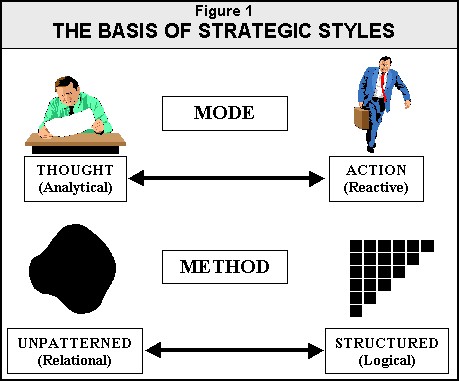
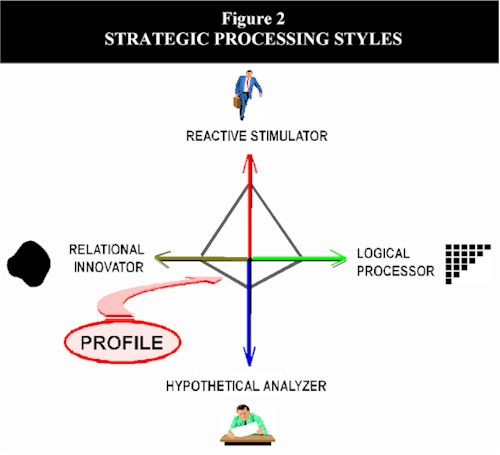
The four strategies outlined above explain the way an individual processes information. There is no “right” or “wrong” way and each style has strengths and vulnerabilities that make it more or less suitable depending on the situation. The style characteristics are briefly described below.
- Reactive Stimulator
The RS favors an action-oriented style. His/her tendency is to react immediately to a situation seeking immediate results. They focus almost exclusively on the task at hand and their target for results is NOW.
- Logical Processor
The LP is logical, methodical and not easily deterred. LPs are detail oriented and prefer clear precise assignments with logical outcomes. They are highly organized, systematic and motivated as long as the information they are processing is well reasoned.
- Hypothetical Analyzer
The HA is a problem solver. HAs enjoy complexity and will carefully consider all alternatives before making a decision. They enjoy the challenge of solving difficult problems and accomplish this by segmenting complex problems into sub problems.
- Relational Innovator
The RI is an idea generator. RIs have the ability to see relationships between divergent ideas and to integrate them into coherent theories and systems. The RI is the innovator and is comfortable exploring new and alternative methods.
Additional clarification of the behavioral attributes embodied in the four strategic styles is provided Table I. Note: The highlighted attributes are highly correlated to TRIZ problem solving situations.
|
|
||||||||||||||||||||||||||||||||||||||||||||||||||||||||||||||||||||||||||||||||||||||||||||||||||||||||||||||||||||||||||||||||||||||||||||||||||||||||||||||||||||||||||||||||||||||||||||||||||||||||||||||||||||||||||||||||||||
* Innovation in conceptual level thinking Note: The definitions for Creativity and Innovation are within the OE context. © 1998, Professional Communications Inc., Used with permission |
||||||||||||||||||||||||||||||||||||||||||||||||||||||||||||||||||||||||||||||||||||||||||||||||||||||||||||||||||||||||||||||||||||||||||||||||||||||||||||||||||||||||||||||||||||||||||||||||||||||||||||||||||||||||||||||||||||
Precise OE is accomplished by assessing an individual or a team on all four dimensions as shown in the Profile plot in Figure 2. A deeper and more descriptive understanding of an individual’s decision-making preferences is gained when the primary and secondary styles are considered in combination. The paired combinations or “strategic patterns” are shown in Figure 3 below. For example, an individual with a primary and secondary styles of RS and LP or vice versa is, within the taxonomy of OE, classified as a “Performer.” Because individuals possess elements of each style, the strategic patterns provide a broader and more stable platform to extrapolate and predict behaviors.
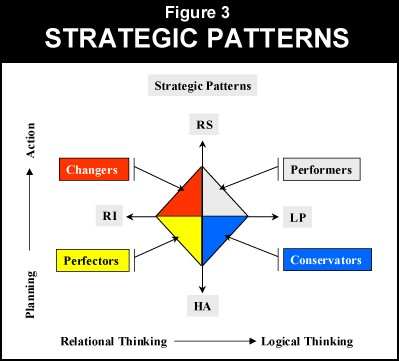
Each of the strategic patterns combines the characteristics of the strategic styles that compose them. This combination, in turn, yields observable and predictable behavioral patterns. The descriptions below provide a thumbnail summary of the characteristics of the four strategic patterns.
- Conservators:
The Conservator profile is a combination of the process oriented LP and the analytical HA. This style is characterized by a strong adherence to procedural and methodological techniques. The Conservator will attempt to generate optimal (ideal) solutions within the boundaries of well-known structures, methods and science. The Conservator style is ideally suited to stable environments with minimum downside risk. The vulnerabilities of the style include “rigidity,” conservative judgments, and “force fitting” the situation to known practices.
- Perfectors:
The Perfector style is the combination of the idea-oriented RI and the analytical HA. The Perfector has little trouble in generating new and novel ideas. Once ideas are generated, they tend to be examined vigorously and refined to a high degree before they are presented for consumption. The strength of the style is the ability to “think out of the box.” The vulnerability of this style is the potential for endless cycles of “idea loops.” This occurs when ideas undergoing the scrutiny of the HA provides the RI with opportunities to think of more new ideas.
- Changers:
The Changer pattern consists of the dual styles of the RI and RS. The primary characteristic of this pattern is the ability to generate many new ideas and then move to implementation without delay. This style is ideally suited when the environment, processes, and technology are undergoing rapid changes. The overriding motivation of the Changer is decisive action and results. The vulnerability of the Changer style is a lack of structure and attention to detail in the implementation of new ideas. Changers are also not in favor of sticking with projects or technologies after they become predictable and routine.
- Performers:
The Performer pattern is composed of the dual styles of the action oriented RS and the process-oriented LP. Both the RS and LP styles have strong action orientation, the difference between Performers and Changers, however, is the Perfector is seeking immediate resolution regardless of how it is obtained. The Changer is interested in the character of the solution—novelty and creativity is typically the content sought. The ideal solution for the Performer is one where near tern concrete results can be quickly achieved.
As stated previously, there are no right or wrong patterns. Each pattern provides the TRIZ practitioner with unique opportunities and vulnerabilities. The question to be answered is “given the characteristics of each strategic pattern, is there an optimal matching of the TRIZ tools to the strategic patterns?” Additionally, “are there any ‘fixes’ that can be employed when the match is less than optimal?”
The TRIZ / OE “Bi-System”:
The Laws of Technological Systems Evolution describe the melding of homogeneous and heterogeneous “mono-systems” into “bi” and “poly-systems.” The combination of the systems in time results in a new “convoluted” mono system. The advantage of the new system is the possession and harmonization of the salient attributes from each of the constituent systems. It is the authors experience that the TRIZ / OE combination provides practitioners with the ability of harmonizing the scientific and sociological dynamics present in any problem solving situation. See Figure 4.
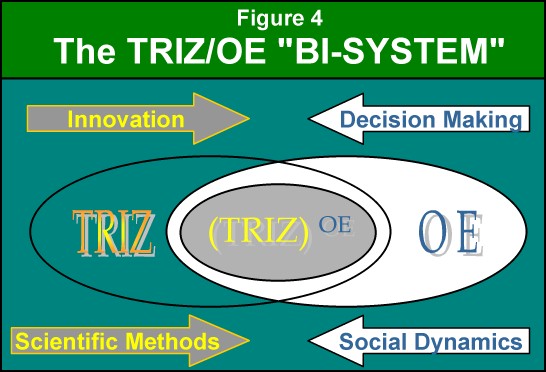
The TRIZ / OE Interface:
TRIZ can be subdivided into two distinct groupings i.e., analytically based tools and analogic tools. Analytical tools require disciplined rigorous step-by-step approaches while analogic tools utilize abstract models, analogs and archetypes. It is the divergent “personalities” of these tools that creates a contradiction and also provides the opportunity for harmonization of the tools with decision making styles. See figure 5.
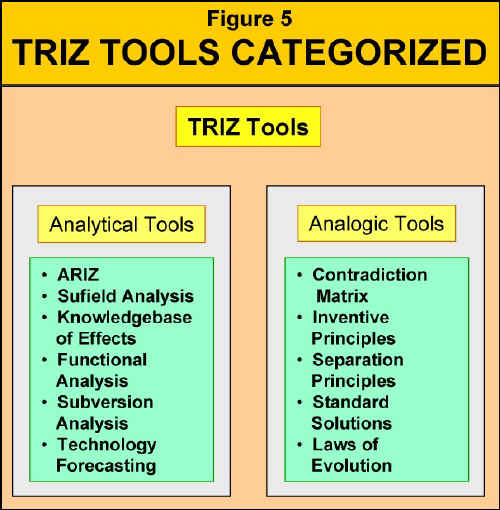
When each team member’s decision profile is known, the matching of individual(s) profiles to the various TRIZ tools becomes straightforward. We wouldn’t for example, expect analytical excellence if the individual prefers the highly relational style of the RI. Likewise, it would, be a poor bet to expect a highly analytical HA to generate radical “out of the box” ideas. Table II below provides a sample listing of OE Strategic Profiles plus the detail style attributes from Table I to relevant TRIZ interfaces.
![]()
|
Strategic Profiles |
||||
| TRIZ Interface |
Performers RS & LP |
Conservators LP & HA |
Perfectors HA & RI |
Changers RI & RS |
| Problem Solving I – Analytical TRIZ Tools |
Low – High |
High – High |
High – Low |
Low – Low |
| Problem Solving II – Analogic TRIZ Tools |
High – Low |
Low – Low |
High – Low |
High – High |
| Creativity |
Medium – Low |
Low – Low |
Low – High |
High – Medium |
| Innovation |
Medium |
Low |
Medium |
High |
The logic of using OE in conjunction with TRIZ is the elimination of the conflict between one’s natural decision strategy and what may be optimal for a given situation. It is axiomatic in Organizational Engineering that every team is optimally suited for something. The issue that must be addressed is – “is the TRIZ team suited for the task at hand?” TRIZ problem solving efforts, like any other “system” works best when the capability of the team is tuned to demands of the problem. When there are disconnects between TRIZ objectives and the team’s capabilities, the effort will be rife with dissonance, internal conflict and, in the end, yield sub-optimal results. Unfortunately, in a scenario with less than hoped for results, many will conclude that the deficiency is attributable to TRIZ and not a result of a mismatch between the strategic decision making styles and type of TRIZ tool used.
Of course it is not possible in all situations to achieve a perfect match between strategic styles and the demands of the TRIZ problem. This is precisely why OE is such a valuable adjunct technology. In addition to delineating, the strengths and vulnerabilities of each strategic style, OE provides specific instructions on how to mechanistically modify the profile of a team through a number of interventions, rules, manipulations and heuristics. Sociological, not psychological tools are employed thus preserving individuals privacy and preferential styles while still being able to improve group outcomes. The case studies that follow illustrate the point.
Case Study 1 Ben & Jerry:
This case study is taken from a large aerospace corporation and illustrates what often happens when workmates posses divergent decision making styles. The individuals in question (Ben and Jerry) held staff engineering positions and had been working together for several years. While there wasn’t any outright hostility between them, it was observed by others in the department that their very different perceptions of problems and potential solutions created a consistent tension and uneasiness. Ben groused that Jerry takes forever to make up his mind. Jerry, on the other hand, viewed Ben’s work as slipshod and “half baked.” The Engineering Manager had a difficult time articulating his concerns and pinpointing the problem but he understood the situation to be problematic and not “quite right.”
The situation and the uneasiness between Ben and Jerry became crystal clear after each had completed the “I-Opt”ä Survey2. Their resulting strategic profiles are shown below. Ben is shown in yellow and Jerry in red. See Figure 6.
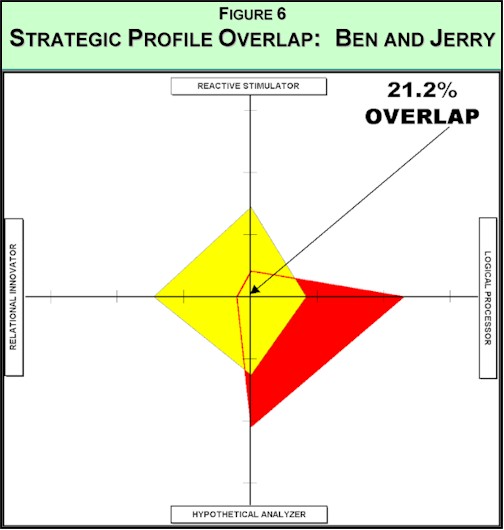
This graphic shows the profiles of Ben and Jerry. The area of overlap shows where the two are likely to reach agreement on issues. The larger the overlap, the more likely that the parties will to view a situation in the same way. This does not mean that will arrive at the same result. It does mean that the approach used has a probability of being of the same character (e.g., levels of detail, risk associated with the idea, focus on action vs. thought, etc.)
The narratives below are verbatim excerpts from the OE report given to Ben and Jerry. They will give the reader a sense of the nature of the analysis involved in assessing a team from an OE perspective.
CHANGER PATTERN
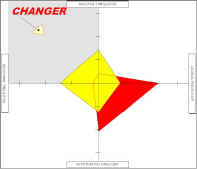 The Changer pattern is a combination of the idea-oriented RI and the action prone RS strategic styles. Characteristics common to these styles are a tendency to omit detail, an enjoyment of variety, relatively short attention spans and a preference for communication in short, intense bursts.
The Changer pattern is a combination of the idea-oriented RI and the action prone RS strategic styles. Characteristics common to these styles are a tendency to omit detail, an enjoyment of variety, relatively short attention spans and a preference for communication in short, intense bursts.
Of the two people, Ben has the greater commitment to the Changer pattern. The pattern is characterized by a tendency to quickly generate new ideas and immediately move to implement them. An “experimental “let’s give it a try” strategy, rather than planning and analysis, is usually favored by people holding Changer pattern convictions. Using this strategy, Ben saves on planning/analysis time but incurs a greater risk of failure as the trade-off. Ben is probably motivated by both the idea and seeing it “in play.”
Jerry may want to keep this inclination in mind when dealing with Ben. Innovation and creativity are probably areas of relative strength as well as a source of personal motivation. If speed counts, downside risk is not great and the issue is amenable to new untested approaches, Ben’s approach might well be encouraged. It could be a valuable contributor to the success the pair has or will enjoy.
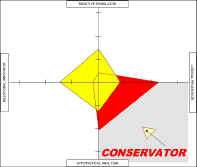 This pattern is a combination of the action oriented LP and the analytically inclined HA strategic postures. The focus of this strategy usually tries to make sure that the intended outcome will actually be achieved and that it is realized with a high degree of precision. “Doing it right.”
This pattern is a combination of the action oriented LP and the analytically inclined HA strategic postures. The focus of this strategy usually tries to make sure that the intended outcome will actually be achieved and that it is realized with a high degree of precision. “Doing it right.”
Jerry may be somewhat more skeptical in accepting new initiatives than might Ben. New, unproven methods always carry a greater risk and this can endanger the certainty that is valued. Ben might find a major contribution to the pairs’ performance in helping identify and “sell” changes of merit.
Relative to Ben, Jerry is probably more concerned with “doing it right” and is probably willing to pay the price of a more measured pace of progress. This may be valuable in situations where time is available and the downside risk of error is heavy. It may also be an opportunity for synergy. Ben might want to “move in” more heavily on those issues where speed is of significance.
This story has a happy ending. After a thorough debriefing the two protagonists were able to appreciate the strength of the other person’s style. Their divergent styles actually were a “blessing in disguise” because the diversity allowed each to tune their assignments to their strengths. Both Ben and Jerry understood the underlying motivations of each and how to frame discussions of various TRIZ problems as to level of detail and divergence from known (typical) solutions. The Engineering Manager was also tuned to the strengths of each style and could make work assignments accordingly. What had been a disagreeable situation for all involved was converted into a competitive advantage for both the people and the firm to which they belonged. No one had to change their preferred strategy; they merely had to learn how to deploy it so that it was coordinated with that of the other team member. Ben was more comfortable with the analogic tools, while Jerry was happier using the analytical tools.
Case Study 2 – Paradigm Paralysis:
The second case study involves a Midwest automotive supplier. In this instance the supplierwas producing a mature commodity product. Market share was declining for the commodity group as a whole as substitutions of different materials nibbled away at the “sales line.” A new General Manager was brought in to “turn things around.” The new General Manager moved quickly to reverse a deteriorating situation. New Policies and Procedures were instituted and a shake-up of senior management occurred with lightning speed. Initiatives to modernize the existing manufacturing processes and a search for new technologies were undertaken. A serious effort to enter totally different markets was investigated. The General Manager fought for and won budget concessions from the parent firm to upgrade the engineering facilities and to purchase the latest Computer Aided Design (CAD) system. After a year and half on the job, the General Manager was fired. In short order, the organization reverted to “the way we’ve always done things around here.”
This situation became known to the author as a result of several TRIZ projects to solve product and process problems. After the analysis of the thirty TRIZ participants from a cross section of the functional departments, the reason for the General Managers demise was obvious. The General Manager exhibited a high degree of RI & RS (Changer) characteristics. The organization was deeply committed to a Conservator (HA & LP) pattern. See Figure 7. 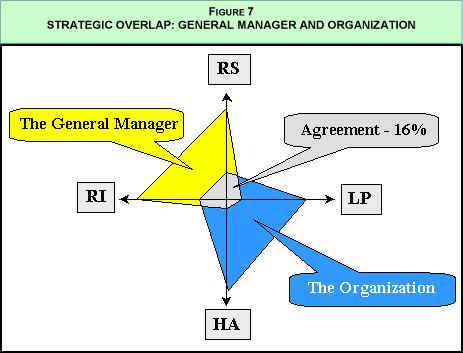 Ironically, this is the same pattern as related in the Ben and Jerry case study. Why such different results?
Ironically, this is the same pattern as related in the Ben and Jerry case study. Why such different results?
The inability to reconcile the two divergent strategic patterns ultimately led to the dismissal of the General Manager. The General Manager relentlessly pushed the organization for new products, new technological approaches, and innovative ides. The frustrations between the General Manager and the staff mounted to a point where the highly committed Conservators fled the organization at the first opportunity. With them went skills critical to the maintenance of the market already captured. The organization was quickly losing its key core competencies in rapid pursuit of “innovation.” The irony is that the General manager was essentially correct in his grasp of the market dynamics, but shortsighted on understanding the organization’s ability to manage the pace and scope of the changes required.
The author‘s work with the TRIZ teams mirrored their strategic profiles. The teams found it very difficult to think of conceptual solutions much beyond the known and comfortable world they had lived in for the last thirty years. Exacerbating the situation was that the “old timers” felt threatened by several of the new hires and essentially dismissed their ideas as outlandish, silly and “off the wall.” After a serious discussion of the situation focused on the strengths and vulnerabilities of each style, the organization began to gel. The need to revitalize the product portfolio through “new” perspectives was accepted.
The OE contribution was a series of interventions that were adopted to mold the company into a more responsive posture. Because of the dominance of strong disciplined decision styles, OE rules were employed to provide context for pursuing innovative objectives at a measured rate (other tools would have been used with teams of a different configuration). A few of the rules that were adopted are outlined in Table III below.
|
|
Sample Rule to Encourage New Ideas:
Sample Rule to Encourage New Ideas:
Sample Rule to Reduce Analysis
Sample Rule to Encourage Expedient Options
|
In six months a new General Manager was hired. His strategic profile is that of a Performer with a secondary orientation to the Conservator style. As one can imagine, the harmonics in the organization are much better. Change is taking place but at a measured pace. The pace and volume of the changes strikes a balance between the need to change for competitive viability and the ability of the organization to internalize the process.
TRIZ Solutions:
The obvious question to a practitioner is can the contradiction in utilization of the TRIZ tools be resolved by TRIZ itself? This is a very interesting question because the situation creates an opportunity for a “non traditional” application of the methodology on the methodology. In short the answer is yes. The three examples below provide evidence of the power of TRIZ and the soundness of the TRIZ/OE Bi-System.
The Problem:
The tools within TRIZ can be divided into two distinct types, analytical and analogic. The nature of the two types of tools is quite opposite with respect to level of detail, precision of the approach, incorporation of analogy, reliance on inference, etc. These differences, in turn, require different mental problem solving models for optimum results. What’s to be done?
Inventive Principles:
The first solution to the problem utilizing the Contradiction Matrix can be derived by comparing the following set of conflicting parameters. See figure 8.
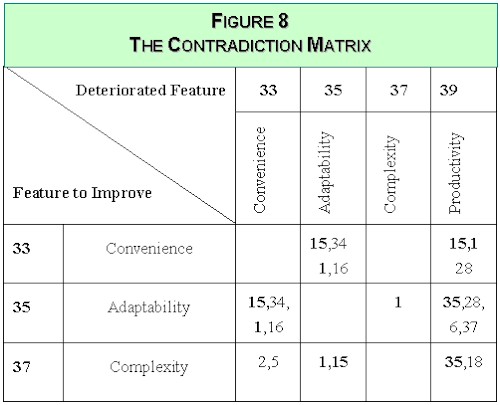
Inventive Principles:
15. Dynamicity. Make the characteristics of an object adjust for optimal performance.
1. Segmentation. Divide an object into independent parts.
35. Parameter Changes. Change the degree of flexibility, concentration, consistency of an object.
The Inventive Principles of Dynamicity, Segmentation, and Parameter Changes indicates that the inherent contradictions can be resolved by carefully matching the decision styles of the individual with the TRIZ tool being utilized. Instead of viewing a team monolithically, OE provides the differentiation and becomes the enabler for the application of the Inventive Principles. Also, the various OE interventions can be applied to a team or an individual to “force” parameter changes in one’s approach to a situation.
Physical Contradiction:
A Physical Contradiction is defined as a situation in which a parameter that must simultaneously exhibit opposite characteristics. Within the context of TRIZ applications, the parameter that must meet this requirement is one’s decision making style. To gain the most from a TRIZ problem-solving project, the decision-making styles have to simultaneously be analytical and reactive, logical and relational.
This contradiction is resolved by the application of the Separation Principle of “Co-existence of Contradictory Properties in one Substance.” The one substance is the team. The contradictory properties are the various style preferences of the team members. OE provides the method by which the team can discern each other’s decision profiles to match preferential styles with the various TRIZ tools in an optimal fashion.
Sufield Models and Standard Solutions:
Substance Field (Sufield) models describe the minimum architecture of a system as consisting of a Field (F), Substance 1 (S1, the Article) and Substance 2 (S2, the Tool). Standard Solutions provide a pictorial representation of how a system can be improved through the application of the appropriate Standard Solution on the Sufield model.
In the problem solving situation, the Field (F) is the cognitive mental capacity of the person, the Article (S1) is the individual’s personal decision strategy and the Tool (S2) is TRIZ. The interesting dilemma is that there is both a useful and harmful interaction between the Tool and the Article. The Tool (TRIZ) provides useful guidance, rigor, analogies and principles for a solution. Simultaneously, however, the Article (decision strategy) impedes the full application of TRIZ tools because of the potential mismatch between the type of TRIZ tool being used and one’s preferred strategic pattern. A Conservator simply will not generate the same solutions as a Changer and vice versa. A mismatch between one’s Strategic Pattern and the TRIZ tool will more than likely result in rework, inefficiency, frustration and a less than optimal solution.
The appropriate Standard Solution for this type of situation is Standard 1-2-2. This Standard states “If two substances experience both a useful and harmful interaction and it is required to break the harmful interaction, a third substance (S3) which is made out of either of the two substances or modifications should be introduced to break the harmful interaction.” In our case, we can modify either the Tool through proper matching to the Article, or we can modify the Article through application of OE rules, interventions, and/or selectively matching strategic profiles with the TRIZ tools.
An analysis of the situation utilizing The Algorithm for Inventive Problem Solving (ARIZ) is consistent with the above solutions and will be published at a future date.
Concluding Thoughts:
Just as systems continue to evolve through the process of combining and recombining with other systems, so too is TRIZ undergoing a metamorphosis. The TRIZ experts who have come to the US and established commercial ventures continue to teach, develop new approaches and devise techniques in this exciting methodology. Those of us who are newly introduced to TRIZ have an obligation to assist in the cultural transformation of TRIZ to make it easier to understand, accept, and practice. It is the author’s experience that Organizational Engineering allows the power inherent in the TRIZ methodology to be more fully realized. It does this by recognizing that human factors and team interrelationships can frustrate or facilitate the realization of TRIZ’s potential. OE offers specific methods by which these relationships can be harmonized to achieve project objectives. Wide application of the TRIZ/OE “Bi-System” can greatly enhance the success we achieve—both in rate and magnitude. It merits of the consideration of professionals in the area.
1Salton Gary J., Organizational Engineering: A New Method of Creating High Performance Human Structures. Ann Arbor: Professional Communications Inc., 1996
2The “I-Opt”ä Survey is the “measuring rod” of Organizational Engineering. It consists of a series of questions designed to reveal decision-making styles. An accompanying computer program produces a multiple page report that helps an individual recognize his or her basic information processing strategy.
References:
- Ungvari, Steven F. 1998 “Engineering the New Product Development Cycle.” Visions. Vol. XXII No.3, Chicago, IL
- Daly, Richard, Ph.D. and David Nicoll, Ph.D. 1997 “Accelerating a Team’s Development.” OD Practitioner. Vol. 29 No. 4
- Parada, Catalina. and Jeffery Miller. 1997 “Designing the A / E Dream Team.” Marketer. Vol. 17 No.1
- Kliem, Ralph L. and Harris B Anderson. 1997 “Teambuilding Styles and Their Impact on Project Management Results.” Project Management Journal. Vol. XXVII No. 1
For additional information:
Strategic Product Innovations, Inc.
7591 Brighton Rd.
Brighton, MI 48116-7722
Voice. 810-220-8440
Fax 810-220-3807
sufield@aol.com
Note: All referenced material is available from SPI, Inc.



